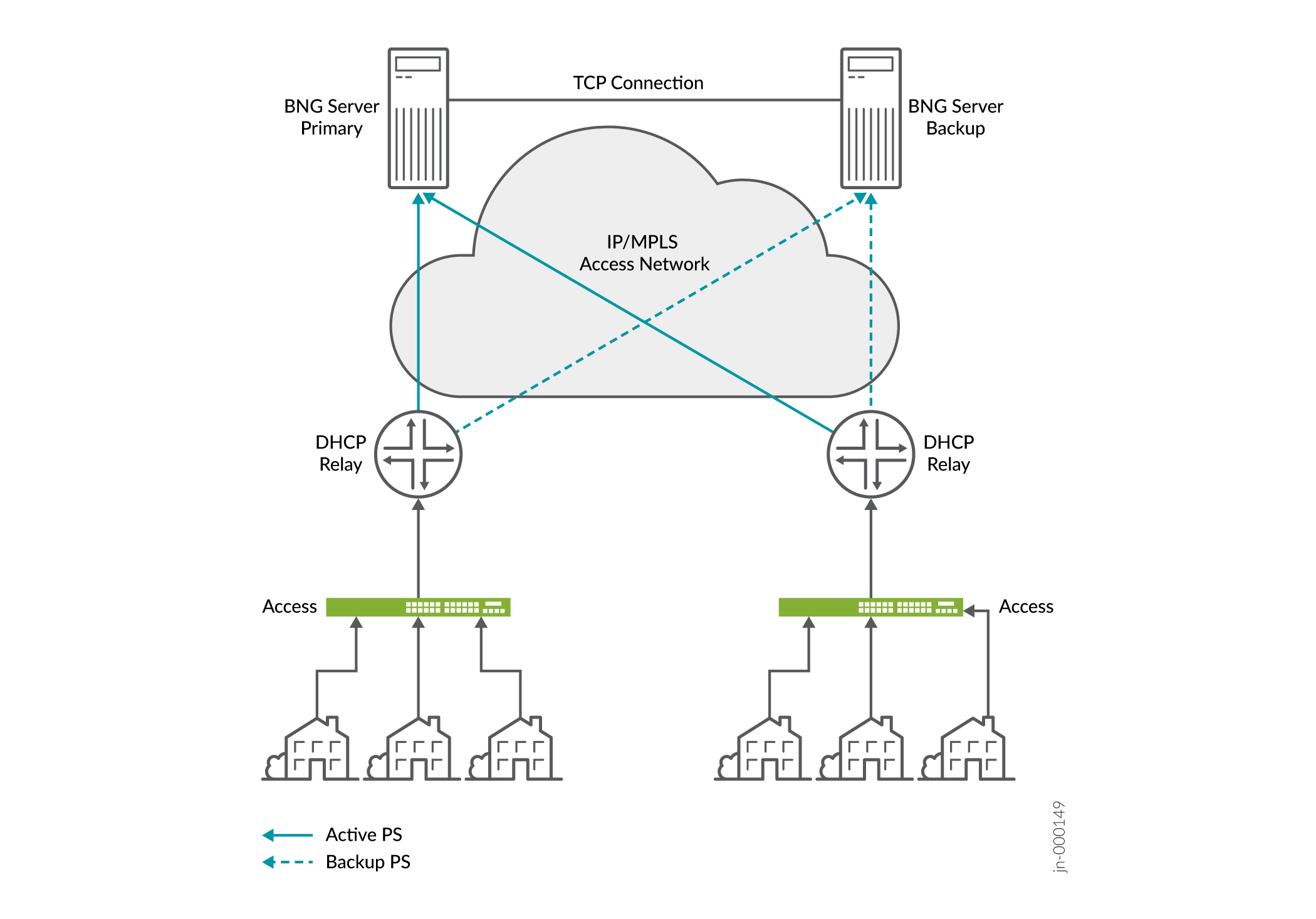N+1 Support for BNG M:N Subscriber Service Redundancy
Learn about N+1 support for broadband network gateway (BNG) M:N subscriber service redundancy, which provides remarkable reduction in the reserved resources for the backup BNG.
N+1 Support for BNG M:N Subscriber Service Redundancy Overview
The N+1 support for BNG M:N subscriber service redundancy is a mechanism to back up multiple primary BNGs to a single backup BNG. This mechanism provides reduction in the reserved resources for redundancy purpose by over-subscribing the secondary Packet Forwarding Engine in backup chassis.
How N+1 Support for BNG M:N Subscriber Service Redundancy Works
Figure 1 illustrates N+1 support for BNG M:N subscriber service redundancy. There are four BNGs shown in the topology. The BNGs A, C, and D are the active BNGs with 64000 dual-stack subscribers on each BNG. The backup BNG B with one line card backing up the other three active BNGs. You can use any MX Series device that can support MPC7 or MX10003 device with LC2103 as a backup BNG.
A1, C1, and D1 are the primary subscriber redundancy groups handling traffic of 64000
subscribers on each BNG. A2, C2, and D2 are the secondary subscriber redundancy
groups in service-activation-on-failover mode.
By default, the M:N subscriber redundancy feature configures the backup BNG in
hot-standby mode. To specifically enable the Packet Forwarding Engine
over-subscription, you need to configure the
service-activation-on-failover mode on the backup BNG.

In this redundancy model we’ve introduced a
service-activation-on-failover mode. In the
service-activation-on-failover mode, you can configure the
subscriber state for an interface using less resources in the backup BNG to forward
traffic. When the primary BNG fails, the traffic switches over to the backup BNG
with basic statistics. The additional services such as CoS and firewall
automatically come to action in the background after the backup interface becomes
active and consumes the additional resources. The operational state of the backup
interface transitions from basic forwarding to full service restoration.
The new programming mode enables the system to consume less resources on the backup
BNG. Hence, you can back up more subscribers when the Packet Forwarding Engine is
not handling any traffic. This backup subscription is known as Packet Forwarding
Engine over-subscription on the backup BNG. With the
service-activation-on-failover mode, you can host three times
more subscribers on the backup BNG than the primary BNGs. The n+1 support for BNG
mode reduces the cost of deploying backup BNGs.
When the subscribers log in to the primary BNGs, the active leasequery brings the
subscriber state to the backup BNG. As the backup BNG hosts the
service-activation-on-failover mode, the backup BNG consumes
minimal Packet Forwarding Engine resources and back ups up to 192000
subscribers.
- Subscriber Service Redundancy When Primary BNG Fails
- Subscriber Service Revert When the Primary BNG Becomes Active
Subscriber Service Redundancy When Primary BNG Fails
Let's see how the system manages when a BNG fails or a BNG becomes inactive. Considering the Figure 1, when the BNG C fails, the subscribers connected to the BNG C re-routes the traffic through the backup BNG B. As soon as the traffic re-routes to the secondary subscriber redundancy group C2, the BNG B performs the following:
- Starts forwarding the upstream and downstream traffic immediately with best-effort.
- Initiates background programming for the services such as CoS and firewall by utilizing the additional resources allocated in BNG B.
- The BNG B restores the full SLA for subscribers and the operational state becomes full-service when the background programming completes.
- The other secondary subscriber redundancy groups A2 and D2 continue to back up the BNGs A and D.
Subscriber Service Revert When the Primary BNG Becomes Active
You can configure the primary BNG C to revert the traffic flow from the backup BNG to the primary BNG when it becomes active. We recommend to use manual revert after checking the state of both BNGs for subscriber programming and confirming that a revert back will succeed. Consider the following scenarios when you enable the auto-revert traffic switchover functionality:
- If the primary BNG fails due to link failure, the background programming of the backup BNG takes several minutes depending on the number of subscribers. A quick revert is not desirable.
- If the primary BNG fails due to the line card or chassis failure, the time to synchronize the original primary chassis or line card using active leasequery or bulk leasequery depends on the number of subscribers.
- The system requires more time to analyze unplanned failures and make the line card or chassis into active service.
N+1 support for BNG M:N subscriber service redundancy does not support redundancy on multiple BNG failures at a time. If multiple BNGs fail at a time, the system back ups only the first BNG. The data of the remaining subscribers on the other failed BNGs are lost completely.
